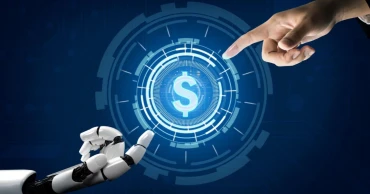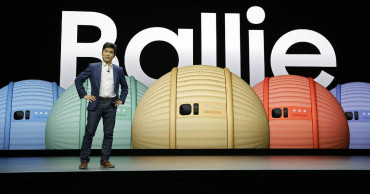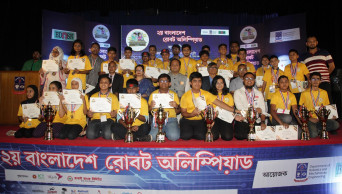Robot
Elon Musk’s bold leap towards driverless future
At the We, Robot event, Tesla CEO Elon Musk once again shook the world of transportation with the reveal of the groundbreaking ‘Cybercab’, a fully autonomous vehicle designed to operate without the traditional controls we’ve come to expect, such as a steering wheel or pedals.
This bold innovation represents Tesla’s most ambitious step yet towards a driverless future, where human intervention in personal vehicles may soon become a thing of the past.
Musk’s vision for the Cybercab is crystal clear: a future where people no longer need to drive their cars, but instead simply sit back and enjoy the ride, whether they are working, relaxing, or even sleeping during their journeys.
Elon Musk unveils Tesla's 'Cybercab,' plans to bring autonomous driving tech to other models in 2025
The Cybercab is a central piece in Tesla's broader strategy to create a world dominated by autonomous vehicles, reshaping the way society thinks about mobility and personal transportation.
A New Era of Autonomous Vehicles
What makes the Cybercab truly remarkable is its absence of any traditional controls. Previous iterations of Tesla’s autonomous technology still required drivers to remain alert and ready to take over in emergencies.
However, the Cybercab takes it a step further by eliminating even the possibility of human intervention. Musk’s ambition is to provide a fully hands-off experience, making passengers mere occupants of the vehicle rather than drivers.
"The Cybercab will be cheaper than mass transit," said Musk during the presentation, further emphasising the economic and technological shift Tesla aims to deliver with this new mode of transportation.
Autonomous Driving Rollout
Tesla’s journey toward fully autonomous vehicles has been long anticipated, and the Cybercab seems to be the culmination of years of innovation and development.
While the Cybercab is expected to begin production in 2026, Musk announced that by next year, Tesla’s Model 3, Model Y, Model S, and the Cybertruck will be equipped with unsupervised, full self-driving capabilities, rolling out initially in Texas and California.
This vision represents a paradigm shift, moving beyond the current expectations of what self-driving cars can do. Rather than focusing on assisting drivers, Tesla aims to remove the need for them altogether.
The Road Ahead
As Tesla continues to push the boundaries of technology, the Cybercab’s introduction is poised to redefine personal transportation.
With the potential to significantly reduce traffic accidents caused by human error, and making the idea of car ownership and use more accessible, it has the potential to disrupt industries far beyond the automotive sector.
However, the road to fully autonomous vehicles is not without challenges, particularly in regulatory approval and infrastructure readiness. Questions remain about how governments and cities will adapt to this new technology, as well as how quickly consumers will embrace it.
Yet, if Elon Musk’s predictions hold true, the future of transportation may be just around the corner—completely driverless, incredibly efficient, and radically different from the cars we know today.
Source: Agencies
1 year ago
AI Robot Chefs: Automated Cooking Could Redefine Food Industry
Technology has revolutionized global networking, communication and traditional work procedures. Then came the Internet of Things or IoT which did the same all over again. In recent years the advancement of AI and robotic technology has reduced many workloads in our day-to-day life. Take cooking for example. Not all people enjoy cooking due to lack of time, skill, or interest. Now, what if we told you, you could get a robot to cook for you? Not just one dish but hundreds of them, all the while maintaining the exact taste every single time. Welcome to the age of AI robot chefs!
Benefits of AI chefs and automated cooking robots
Besides taking up the cooking challenge, AI robot chefs are also streamlining the process of food preparations. It’s making life easier with one less thing to worry about. For the culinary industry, AI robots are a game changer considering the efficiency they bring to the table.
To sum up the benefits, AI and automated cooking robots can
- solve the understaffing problem
- bring smart kitchen collaboration
- avoid the risk of food contamination
- minimize food waste.
Read more: AI & Future of Jobs: Will Artificial Intelligence or Robots Take Your Job?
Best AI Robot Chefs of 2023
Most AI chefs today are made for industrial-scale operations. The main aim is to reduce human interaction and make the process of large-scale cooking easier. While a good number of AI cooking robots are still in the development stages, only a few have moved to industrial operations. Here’s our pick of the most advanced AI robot chefs operating in 2023.
Flippy 2: The AI-powered frying chef
Flippy 2 is the successor of Flippy, a robotic fry cook chef from Miso Robotics based in the USA. The new iteration brings AI integration to the already successful Flippy. And the results are incredible, to say the least.
Flippy 2 is designed for industry-grade frying solutions. The robot uses separate baskets to fry different items at different temperatures. In this robot, the manufacturer has utilized a new feature called the AutoBin technology. This mechanism has been especially designed for low-volume specialty foods that cannot be fried in a large batch. For example, onion rings. The AutoBin automatically can efficiently monitor the raw material, frying size, and time. It can also decide the hot-holding time to wick away the extra oil after frying.
Flippy 2 has undoubtedly reduced human contact ranging from placing the raw foods in the basket to preparing served portions. The closed-loop system increases productivity by 30% as claimed by Miso Robotics.
Read more: Ai and Future of Content Writing: Will Artificial Intelligence replace writers?
Nosh by Euphotic Lab: Automated cooking robot
Healthy home food is just a NOSH away” – that’s the tagline of Euphotic Lab’s home cooking solution. What is interesting about Nosh is that its design has nothing like what we generally see in a robot chef. Usually, the robot chefs are large in shape bearing bulky robotic arms to move around stuff. Nosh is an automated robot chef featuring the design and size of a microwave oven.
2 years ago
How to Make Money with AI for Beginners and Professionals
Artificial Intelligence (AI) has become a game-changer, transforming industries and how we use technology. As AI and its use grow, many opportunities are also becoming available for people to earn from their skills and knowledge. Whether you are new to AI or an experienced person seeking new opportunities using AI, there are several ways to make money with AI. Let's explore ten profitable ways suitable for beginners and professionals to make money with AI in Bangladesh.
How Beginners and Professionals Can Generate Income with AI
From healthcare to entertainment, AI has completely transformed various industries. As AI keeps progressing, it creates countless opportunities for individuals to utilize it and earn money.
Developing AI Applications
One of the easiest ways to make money using AI skills is by creating AI applications for companies and individuals. For example, you can make special apps like chatbots to help customers, recommendation systems to give personalized suggestions, or systems that can recognize objects in pictures. If you are just starting out, you can begin with tools like TensorFlow or PyTorch, and as you practice more, you will get really good at making AI programs for different things. This will be a strong base for creating all kinds of cool AI applications.
Read more: StarLink: What's special about Elon Musk's SpaceX satellite internet service?
AI Consulting
Having a profound understanding of AI and its practical applications can lead you to highly rewarding opportunities by offering consulting services. Numerous businesses are eager to implement AI but may lack the expertise to do it effectively. As a consultant, you can assist them in defining AI strategies, choosing suitable technologies, and optimizing existing AI models. This also enables professionals to share their industry insights and experiences.
Generative AI Content
Earning income online by sharing your content has become a popular method. Two main approaches are commonly used: placing ads on blog posts and posting sponsored content on social media.
You can research and create quality content with the help of AI and boost your earnings. However, consistency is key to maintaining a steady income. You must regularly create interesting and unique content to stand out from others.
Read more: How AI Can Improve Education
Using AI-based tools can significantly aid you in this endeavor. For instance, a tool like Jasper can assist you in generating ideas, conducting research, and writing drafts at a faster pace. It can create content for various platforms, such as blog posts, Instagram captions, or YouTube scripts. This way, you can save time, boost productivity, and expand your online presence.
2 years ago
Top 10 Humanoid AI Robots in 2023 So Far
Rapid technological progress has ushered in a new era of innovation in the field of AI and robotics. Diverse functional humanoid robots have already captured the attention of the scientific communities and the general people. Besides resembling and mimicking human beings in terms of appearance, the humanoid AI robots are designed to work for special purposes such as healthcare, entertainment, customer service, education applications, etc. Let’s take a look at the smartest humanoid robots in the world in 2023 so far.
World’s 10 Most Advanced Humanoid Robots in 2023
Ameca
Ameca, developed by Engineered Arts in 2021, stands as the epitome of sophistication among humanoid robots, surpassing all others in terms of advancement and realism. The debut of Ameca's inaugural video on December 1, 2021, garnered tremendous acclaim across Twitter and TikTok, capturing the attention of countless individuals. Its primary purpose revolves around propelling the field of robotics by exploring human-robot interaction.
Ameca incorporates an array of cutting-edge features, including embedded microphones, binocular eye-mounted cameras, a chest camera, and facial recognition software, enabling seamless engagement with the public. Furthermore, the interactions can be controlled either through GPT-3 or human telepresence. The utilisation of state-of-the-art technology extends to its artificial limbs, ligaments, and sensor arrays, underscoring its remarkable design.
Read more: Ameca: World’s Most Realistic Advanced Humanoid Robot AI Platform
Nadine
Nadine, an empathetic android developed by Japanese company Rokoro, emerged in 2013 as an exceptional creation. This social robot was modelled on Professor Nadia Magnenat Thalmann.
2 years ago
BUET hosts 'Robo Carnival' for schools, colleges, varsities
The Bangladesh University of Engineering and Technology (BUET) has launched a two-day long 'Robo Carnival' to inspire students to make robots to make smart Bangladesh with the slogan 'Build Robot for Smart Bangladesh'.
The two-day long carnival starts at the ECE building around 10 am today (January 19) and BUET vice Chancellor Dr Sattyaprashad Majumdar was the chief guest.
About 500 students, divided into 125 groups, from the different schools, colleges and universities of the country are taking part in the two-day carnival.
The carnival has been arranged to teach and inspire the students about different segments of Robotics like dust collecting robot competition, and firefighter robot competition.
Besides the firefighter robot and trash collector robot competition, a project showcasing part, a workshop on Robotics Simulation software and a robotics olympiad for the competitors have been arranged.
Tarikul Islam Tanvir, a student of Gopalganj Polytechnic Institute, who has developed an 'Earthquake digital safety system', said on his project: "We know that when an earthquake happens, many people die from being electrocuted. The safety system that I have developed will reduce the danger of being electrocuted in case any earthquake happens."
"This safety system can detect earthquake vibration automatically and immediately after it cuts off the electricity lines and water supply lines. Besides, it sends automatic calls to alert the user about the earthquake. This system can be installed in every residential house and industrial sector but if the device is installed in district supply lines then there is no need to install the system separately in individual houses or industrial factories," Tanvir added.
At the initial stage, BUET students took initial tests and presentations of the projects and later BUET teachers evaluated those projects.
Read more: Ameca: World’s Most Realistic Advanced Humanoid Robot AI Platform
2 years ago
Xiaomi launches humanoid robot CyberOne
Chinese phone maker Xiaomi has unveiled a full-sized humanoid robot named CyberOne.
Fitted with advanced legs and arms, the robot supports bipedal-motion posture balancing and has a peak torque of 300Nm.
Xiaomi claims CyberOne can detect human emotions and even create 3D visual representations of the world.
Read: Humanoid robot made by Cumilla students turns heads
"CyberOne's AI and mechanical capabilities are all self-developed by Xiaomi Robotics Lab. We have invested heavily in research and development spanning various areas, including software, hardware, and algorithms innovation," Lei Jun, the founder, chairman and CEO of Xiaomi Group, said.
The company revealed that CyberOne weighs 52kg and has a height of 177cm and an arm span of 168cm.
Compared to a quadruped robot, this humanoid robot is more mechanically complex, requiring more powerful motors, more degrees of freedom, and complex humanoid biped control algorithms.
Read Robot artist sells art for $688,888, now eyeing music career
Xiaomi's humanoid robot CyberOne reportedly has 21 degrees of freedom in motion with a real-time response speed of 0.5ms for each degree, allowing it to easily simulate human movements.
3 years ago
Training on ‘Robot making’ underway in Cumilla amid students’ enthusiasm
A training programme on ‘making robots’ for students of classes V to X started at the laboratories of Cumilla Collectorate School & College and District administration lab creating enthusiasm among young learners.
Organized by Cumilla Robotics and Programming Club the objective of the training is to improve the technological knowledge among the students and make them interested in scientific inventions.
Over 700 students from 16 educational institutions in Cumilla city first took part in a three-day workshop. From among them, 120 students were selected for this training, said assistant Commissioner Kaniz Fatema, officer-in-charge of the ICT department of the district administration.
Read AI & Future of Jobs: Will Artificial Intelligence or Robots Take Your Job?
Besides, training will be arranged in every upazila on the initiative of Cumilla Robotics and Programming Club, she added.
During a visit the UNB correspondent found the students busy with their training. In the district administration lab, the body print of the robot is running on the 3D printer. In addition, students are working with sensors.
Mahmuda bin Mohsin, a 10th grader of Cumilla High School, said, “I can learn many things from this training. This is a new experience. I hope I can do something good through this workshop”.
Read How Can Artificial Intelligence Improve Healthcare?
Shirin Akhter, a guardian, said “My daughter Jinat Akhter is in 10th grade. She has been interested in technology since childhood. She is very happy to come to this workshop”.
3 years ago
Robot artist sells art for $688,888, now eyeing music career
Sophia is a robot of many talents — she speaks, jokes, sings and even makes art. In March, she caused a stir in the art world when a digital work she created as part of a collaboration was sold at an auction for $688,888 in the form of a non-fungible token (NFT).
The sale highlighted a growing frenzy in the NFT market, where people can buy ownership rights to digital content. NFTs each have a unique digital code saved on blockchain ledgers that allow anyone to verify the authenticity and ownership of items.
David Hanson, CEO of Hong Kong-based Hanson Robotics and Sophia's creator, has been developing robots for the past two and a half decades. He believes realistic-looking robots can connect with people and assist in industries such as healthcare and education.
Sophia is the most famous robot creation from Hanson Robotics, with the ability to mimic facial expressions, hold conversations and recognize people. In 2017, she was granted Saudi Arabian citizenship, becoming the world’s first robot citizen.
Also read: Japan hotel uses robot staff for coronavirus patients
“I envisioned Sophia as a creative artwork herself, that could generate art,” Hanson said in an interview.
“Sophia is the culmination of a lot of arts, and engineering, and the idea that she could then generate art was a way for her to emotionally and visually connect with people,” he said.
Sophia collaborated with Italian artist Andrea Bonaceto, who drew portraits of Sophia. Sophia then processed his work via neural networks and proceeded to create a digital artwork of her own.
The digital work that sold for $688,888 is titled “Sophia Instantiation”, and is a 12-second video file which shows Bonaceto’s portrait evolving into Sophia’s digital painting. It is accompanied by the physical artwork painted by Sophia.
The buyer, a digital artwork collector and artist known as 888 with the Twitter handle @Crypto888crypto, later sent Sophia a photo of his painted arm. The robot then processed that, adding that image to her knowledge and painted more strokes on top of her original piece.
In a tweet on Sophia’s account, the work was described as the first NFT collaboration between an “AI, a mechanical collective being and an artist-collector.”
“As an artist, I have computational creativity in my algorithms, creating original works,” Sophia said when asked what inspires her when it comes to art. “But my art is created in collaboration with my humans in a kind of collective intelligence like a human-artificial intelligence hive mind.”
Sophia’s artwork selling as an NFT is part of a growing trend. In March, a digital artwork by artist Beeple — whose real name is Mike Winkelmann — sold for nearly $70 million, shattering records and making it the most expensive digital artwork ever sold.
Henri Arslanian, PricewaterhouseCooper’s Global Crypto Leader, said that NFTs give people “bragging rights” of the assets that they own.
Also read: Japan to build dam entirely with robots
“And what is really amazing with NFT is that it not only allows you to actually show to the broader world that you own this, but it really creates this bond between the holder of the NFT and the artists,” he said.
It also allows art to be sold without traditional intermediaries, so that artists can connect directly with buyers without being constrained by galleries or auction houses, Arslanian said.
Sophia will carry on painting, Hanson said, and the next step in the robot's career could be that of a musician. She is working on several musical works in a project called Sophia Pop, where she collaborates with human musicians to generate music and lyrics, he said.
“We’re so excited about Sophia’s career as an artist,” Hanson said.
4 years ago
CES tech show: Say no to junk food; machines make cocktails
A wristband that will help you say "no" to junk food. A machine that will mix drinks for you.
5 years ago
Robot Olympiad begins at DU
Dhaka, Sept 7 (UNB) - A two-day long Bangladesh Robot Olympiad started at the premises of Teacher-Student Centre (TSC) of Dhaka University (DU) on Saturday.
6 years ago







.jpg)









